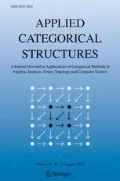Abstract
We relate two approaches to Quantitative Domain Theory, the partial metrics of Steve Matthews and the measurements of Keye Martin, by showing that stable partial metrics are in one-to-one correspondence to weakly modular measurements. It is shown that every ω-algebraic domain admits a partial metric whose associated measurement assigns zero precisely to the set of maximal elements, a condition which features prominently in Martin's work. A partial metric gives rise to a metric in a standard way; we study the conditions under which the resulting space is complete and show that every ω-algebraic domain admits a partial metric of this kind. We discuss a number of examples and counterexamples to locate the strength of our results more exactly.
Similar content being viewed by others
References
Abramsky, S. and Jung, A.: Domain theory, in S. Abramsky, D. M. Gabbay and T. S. E. Maibaum (eds), Handbook of Logic in Computer Science, Vol. 3, Clarendon Press, 1994, pp. 1–168.
Edalat, A. and Heckmann, R.: A computational model for metric spaces, Theoretical Computer Science 193(1–2) (1998), 53–73.
Engelking, R.: General Topology, Sigma Series in Pure Mathematics, Heldermann Verlag, 1989.
Flagg, R. C.: Quantales and continuity spaces, Algebra Universalis 37(3) (1997), 257–276.
Flagg, B. and Kopperman, R.: Continuity spaces: Reconciling domains and metric spaces, Theoretical Computer Science 177(1) (1997), 111–138.
Frink, A. H.: Distance functions and the metrization problem, Bulletin of the American Mathematical Society 43 (1937), 133–142.
Gierz, G. K., Hoffmann, K. H., Keimel, K., Lawson, J. D., Mislove, M. W. and Scott, D. S.: A Compendium of Continuous Lattices, Springer-Verlag, Berlin, 1980.
Heckmann, R.: Power domain constructions (Potenzbereich-Konstruktionen), PhD thesis, Universität des Saarlandes, December 1990.
Heckmann, R.: Approximation of metric spaces by partial metric spaces, Applied Categorical Structures 7 (1999), 71–83.
Hofmann, K. H. and Mislove, M.: Local compactness and continuous lattices, in B. Banaschewski and R.-E. Hoffmann (eds), Continuous Lattices, Proceedings Bremen 1979, Lecture Notes in Mathematics 871, Springer-Verlag, 1981, pp. 209–248.
Künzi, H.-P. and Vajner, V.: Weighted quasi-metrics, in Proceedings of the 8th Summer Conference on Topology and Its Applications, Vol. 728, 1992, pp. 64–77.
Lawson, J. D.: Spaces of maximal points, Mathematical Structures in Computer Science 7(5) (1997), 543–555.
Martin, K.: The regular spaces with countably based models, Theoretical Computer Science, to appear.
Martin, K.: A foundation for computation, PhD thesis, Department of Mathematics, Tulane University, New Orleans, LA 70118, 2000.
Matthews, S. G.: Partial metric topology, in Proceedings of the 8th Summer Conference on Topology and Its Applications, Vol. 728, 1992, pp. 176–185.
O'Neill, S. J.:Partial metrics, valuations and domain theory, Research Report CS-RR-293, Department of Computer Science, University of Warwick, Coventry, UK, October 1995.
O'Neill, S. J.: Two topologies are better than one, Research Report CS-RR-283, Department of Computer Science, University of Warwick, Coventry, UK, March 1995.
O'Neill, S. J.: A fundamental study into the theory and application of the partial metric spaces, PhD thesis, University of Warwick, Department of Computer Science, March 1998.
Plotkin, G.: \({\mathbb{T}}^\omega \) ω as a universal domain, Journal of Computer and System Sciences 17 (1978), 209–236.
Schellekens, M. P.: A characterization of partial metrizability. Domains are quantifiable, to appear in Theoretical Computer Science.
Smyth, M. B.: Quasi-uniformities: Reconciling domains and metric spaces, in M. Main, A. Melton, M. Mislove and D. Schmidt (eds), Proceedings of the Workshop on Mathematical Foundations of Programming Language Semantics, Lecture Notes in Computer Science 298, Springer, New York, 1988, pp. 236–253.
Waszkiewicz, P.: Quantitative continuous domains, PhD thesis, School of Computer Science, The University of Birmingham, Edgbaston, B15 2TT, Birmingham, UK, May 2002.
Author information
Authors and Affiliations
Rights and permissions
About this article
Cite this article
Waszkiewicz, P. Quantitative Continuous Domains. Applied Categorical Structures 11, 41–67 (2003). https://doi.org/10.1023/A:1023012924892
Issue Date:
DOI: https://doi.org/10.1023/A:1023012924892



